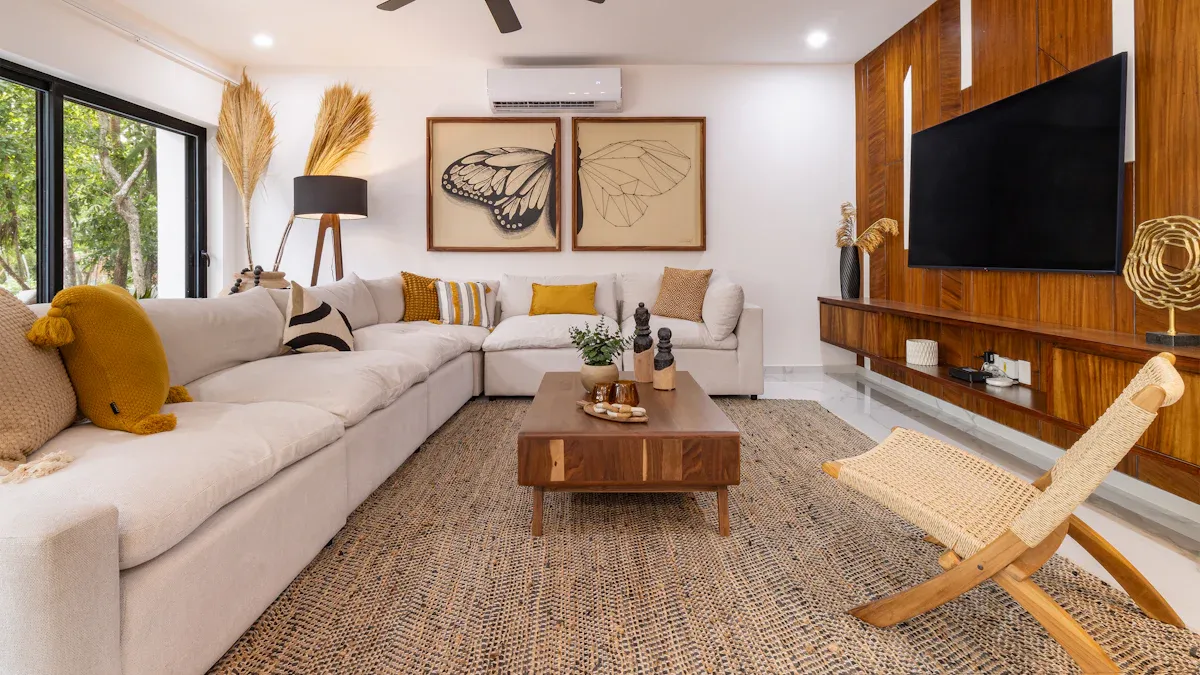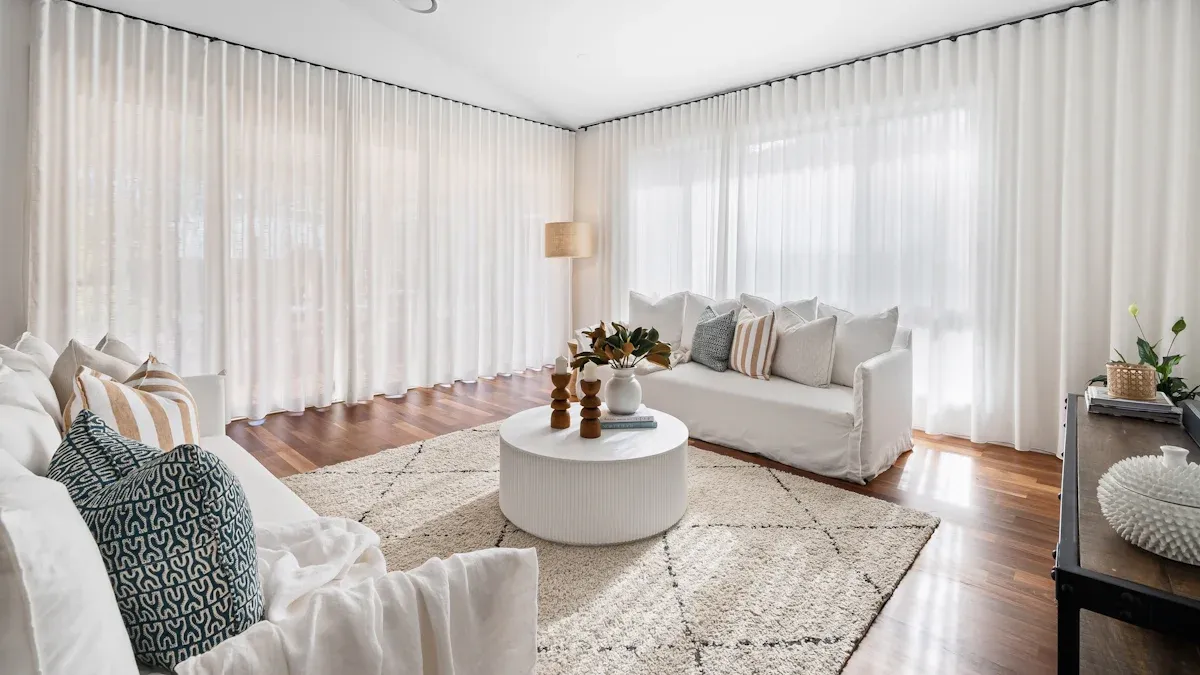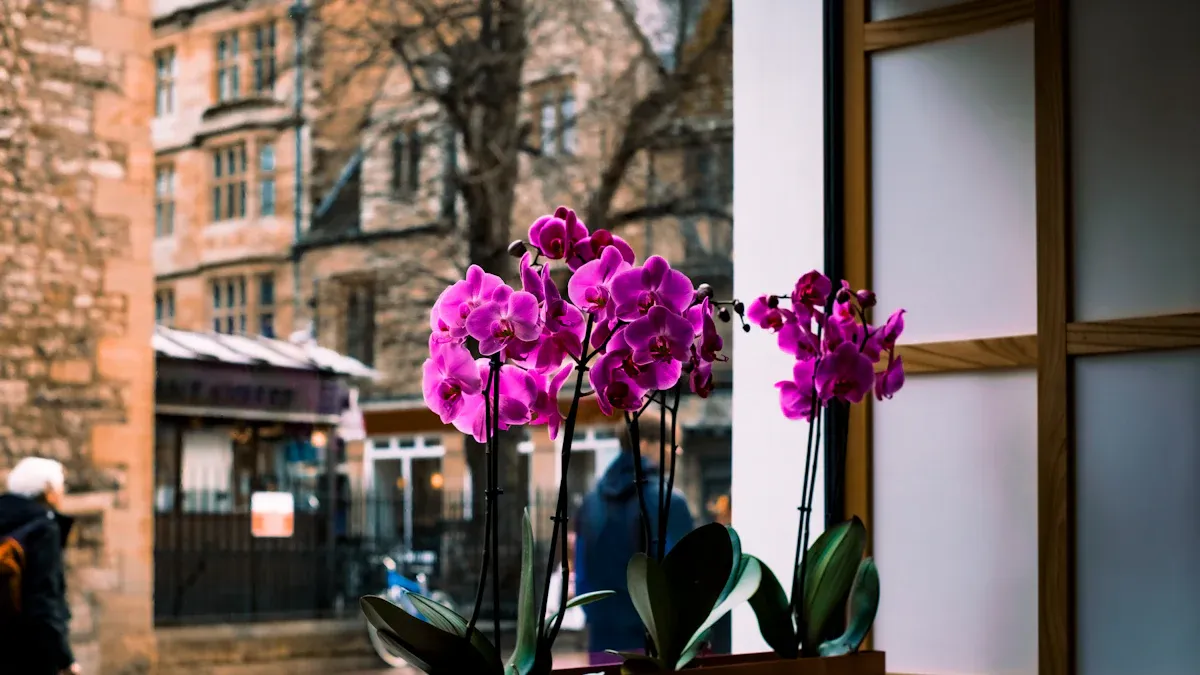
To create a warm and inviting atmosphere in your living room feng shui layout, it's essential to ensure that the space has good energy. Here are some easy ideas to achieve this:
Ensure you have a clear view of the entrance. This allows Qi to flow freely and makes your room feel welcoming.
Incorporate the five elements—wood, fire, earth, metal, and water—to establish a natural balance in your living room feng shui layout.
Combine soft and strong elements to achieve a harmonious balance of Yin and Yang.
Eliminate clutter, as a clean room promotes relaxation and a positive vibe.
Arrange your furniture in a way that feels comfortable and encourages conversation. The ideal feng shui layout for your living room will create a cozy environment and foster connections among people.
Key Takeaways
Put your sofa so it faces the door. This helps energy move better and makes guests feel happy to come in.
Add wood, fire, earth, metal, and water in small ways. This helps your room feel balanced and peaceful.
Make sure your living room is neat and clean. A tidy room helps you relax and brings good energy.
Use sunlight and gentle, warm lights to make your living room feel nice and bright.
Place plants and happy decorations to make the room feel calm and friendly.
Feng Shui Living Room Principles
Balance Five Elements
When you want to create a balanced feng shui living room, you need to think about the five elements: Wood, Fire, Earth, Metal, and Water. Each one brings something special to your space. If you use them together, you help energy flow and make your room feel just right.
Here’s how you can bring each element into your living room:
Wood: Add wooden furniture or indoor plants. Wood stands for growth and fresh energy.
Fire: Use red pillows, candles, or let in lots of sunlight. Fire brings passion and excitement.
Earth: Choose warm colors or clay pots. Earth gives your room a sense of stability.
Metal: Try metallic frames or sculptures. Metal helps you focus and keeps things organized.
Water: Place a small fountain, a mirror, or use blue accents. Water brings calm and renewal.
Tip: Try to include a little bit of each element. You don’t need to use all of them in big ways. Even small touches can make a big difference when you’re curating good feng shui.
Here’s a quick guide:
Element |
What It Means |
How to Add It |
|---|---|---|
Wood |
Growth, vitality |
Plants, wood tables |
Fire |
Passion, energy |
Candles, sunlight |
Earth |
Stability, support |
Clay pots, warm tones |
Metal |
Focus, clarity |
Metal decor |
Water |
Calm, flow |
Mirrors, blue colors |
Balancing these elements helps your living room feel lively and peaceful at the same time.
Yin and Yang Harmony
You want your living room to feel both lively and relaxing. That’s where Yin and Yang come in. Yang is bright, active, and energetic. Yin is soft, calm, and restful. In a living room, you usually want more Yang because it’s a place for fun and talking. But you also need some Yin so everyone feels comfortable.
Use bright colors or statement pieces, like a bold couch, to add Yang.
Add soft textures, like a cozy rug or gentle artwork, for Yin.
Arrange your seating so people face each other. This helps everyone feel welcome and keeps the energy balanced.
Keep the room tidy and let in natural light. This makes the space feel open and warm.
If you balance Yin and Yang, your living room will feel just right. People will want to stay, talk, and relax. You’ll notice that guests feel at ease, and the mood stays positive.
Living Room Feng Shui Layout

Welcoming Furniture Layout
When you walk into your living room, you want to feel relaxed and at home. The way you arrange your furniture can make a big difference in the energy of the space. A welcoming furniture layout starts with a clear view of the entrance. This helps Qi move freely and makes guests feel safe and comfortable.
You should place your sofa so it faces the door. This simple step improves the flow of energy and lets you see who comes in. Try to put the sofa against a solid wall. This gives you a sense of support and security. If you can't use a wall, a tall bookshelf or screen behind the sofa can help you feel anchored.
Arrange your chairs and couches so people can talk easily. A U-shaped setup around a coffee table encourages conversation and connection. This layout also helps Qi move in a gentle circle, making the room feel lively and balanced.
Tip: Rounded furniture, like oval coffee tables or chairs with soft edges, helps soften the energy in your living room feng shui layout. These shapes make the space feel cozy and safe. You can use a mix of textures and colors to create a balanced look that feels inviting.
Here's a quick table to show how these choices affect your living room feng shui layout:
Feature |
Feng Shui Benefit |
|---|---|
Sofa facing entrance |
Welcoming, improves energy flow |
Sofa against solid wall |
Security, support, comfort |
U-shaped arrangement |
Encourages conversation, positive energy |
Rounded furniture |
Harmony, stability, safety |
Clear view of entrance |
Positive Qi flow, welcoming atmosphere |
If you want your living room feng shui layout to feel open and friendly, make sure you can move easily between pieces of furniture. Avoid blocking windows or pathways. This keeps the energy moving and helps everyone feel at ease.
Clutter-Free Space
A clutter-free space is key to good feng shui. When you declutter the living room, you clear blocked energy and make room for harmony. Studies show that clutter can raise stress and make it hard to relax. If you keep your living room tidy, you help Qi flow and boost your mood.
Space clearing starts with putting away things you don't need. Use shelves and cabinets to store items. If you haven't used something in a year, think about donating or selling it. Limit sentimental clutter so your space feels light and open.
Note: Feng shui experts say that a clear entryway is important. When you walk in, you should feel calm and welcome. Space clearing by zones makes the process easier. Start with one area, then move to the next.
Here are some easy steps for space clearing in your living room feng shui layout:
Keep surfaces clean and free of clutter.
Use only the furniture you need. Too many pieces can make the room feel cramped.
Arrange furniture so you can walk around easily. This helps Qi move without getting stuck.
Store items out of sight to keep the space peaceful.
Declutter the living room regularly to maintain harmony.
When you clear clutter, you create a space where you can relax and connect with others. After you finish space clearing, add touches of the five elements to keep the energy balanced. Plants, soft lighting, and calming colors like green or blue can make your living room feng shui layout feel even better.
Light, Mirrors, and Energy Flow
Lighting Tips
Lighting shapes the mood and energy in your living room. Natural light brings life into your space and helps Qi move freely. When you let sunlight in through big windows or skylights, you boost your mood and fill the room with positive energy. Sunlight is the main source of good energy in Feng Shui. It makes your living room feel open and welcoming.
You can use these lighting strategies to keep your space balanced and bright:
Lighting Strategy |
Description |
|---|---|
Soft, warm lighting |
Use warm white or soft yellow bulbs for a cozy feel. Avoid harsh lighting. |
Layered lighting |
Mix different light sources. Try table lamps, floor lamps, and wall lights. |
Light up dark corners |
Place lamps in corners to keep Qi moving and prevent energy from getting stuck. |
Use dimmer switches |
Adjust brightness to fit your mood or activity. |
Avoid fluorescent lighting |
Harsh lights can make you feel tired or irritable. |
Task and accent lighting |
Use lamps to highlight art or reading spots. |
Tip: Use bulbs that mimic sunlight. They help brighten your space and save energy. Try both low and high lights to lift the energy in your living room.
You can also follow these steps:
Find dark corners and add lamps to keep energy flowing.
Mix different lights for a soft, layered look.
Pick warm, gentle lights to make everyone feel at home.
When you layer your lighting, you balance Yin and Yang. Soft lights help you relax, while brighter lights keep things lively. Remember to place your tv mindfully so it does not reflect harsh light or create glare.
Mirror Placement
Mirrors can make your living room feel bigger and brighter. They reflect light and help Qi move around the room. Place mirrors on the north or east walls to bring in positive energy. Keep mirrors clean and well-lit for the best effect.
Here are some simple tips for mirror placement:
Hang mirrors 4-5 feet above the ground.
Use square or rectangular mirrors for a stable feeling.
Avoid putting mirrors where they face the front door. This can push good energy out of your home.
Do not place mirrors facing clutter, toilets, or stairs. These spots can create stress or imbalance.
Make sure mirrors do not face each other. This can cause energy to bounce around and feel chaotic.
Note: Mirrors that reflect sunlight or a beautiful view can double the positive energy in your living room. But if a mirror shows clutter or mess, it can make the space feel more stressful.
If you put a mirror in a dark corner, it might make the area feel even heavier. Always check what your mirror reflects. A good reflection brings harmony and helps everyone feel calm and happy.
Accessories and Plants

Positive Energy Decor
You can boost the good vibes in your living room with the right accessories. Feng Shui teaches that the things you choose and where you place them can shape the flow of Qi and help everyone feel at ease. Try adding thoughtful items that act as “energy anchors.” These pieces remind you of happy moments and bring a sense of harmony.
Here are some popular decor choices for positive energy:
Crystals like amethyst, citrine, and rose quartz. People believe these stones can lift your mood and bring healing energy.
Mirrors help expand your space and double the positive Qi. Place them where they reflect light or a beautiful view, but avoid facing the front door.
Plants such as English ivy, peace lily, or succulents. These add life force and freshen the air.
Natural materials like wood, clay, or stone. These connect you to nature and create a calming effect.
Wind chimes and gentle artwork. These can help Qi move smoothly and make your space feel peaceful.
Tip: Use the Bagua map to find spots in your living room that need a boost. A small crystal or plant in the right place can make a big difference.
Best Indoor Plants
Plants do more than just look nice. They bring nature indoors and help balance the energy in your living room. Some plants are famous in Feng Shui for their power to attract luck, joy, and harmony.
Here are some top picks:
Anthurium Clarinervium: Heart-shaped leaves stand for love and peace.
Bird of Paradise: Bright flowers and leaves bring joy and good fortune.
Baby Rubber Plant: Supports growth and well-being.
Burgundy Rubber Tree: Adds stability and helps you feel grounded.
Fittonia: Known for boosting positive energy and helping you overcome challenges.
Peace Lily: Cleans the air and brings calm.
Bamboo Palm: Adds a tropical touch and helps filter the air.
Spider Plant and ZZ Plant: Easy to care for and great for beginners.
Studies show that houseplants like these can remove some indoor air pollutants, though natural airflow matters more for fresh air. Remember to dust your plants and avoid overwatering, since too much moisture can cause mold. Choose plants that fit your lifestyle and make you smile every time you walk into the room.
You can create a balanced living room by following a few simple steps. Here’s a quick guide:
Step |
What to Do |
|---|---|
1 |
Start with your biggest furniture, like the sofa, and face it toward the door. |
2 |
Let in fresh air and natural light. Use sheer curtains and open windows often. |
3 |
Keep your entryway bright and clear of clutter. |
4 |
Add the five elements—wood, fire, earth, metal, and water—throughout the room. |
5 |
Place healthy plants to boost air quality and bring life inside. |
Studies show that plants, natural light, and less clutter can help you feel calmer and more comfortable at home.
Try one small change today.
Open a window for fresh Qi.
Add a new plant or tidy up a corner.
Notice how your space feels.
You might be surprised at how much better your living room feels with just a few tweaks!
FAQ
What is the best color for a feng shui living room?
You can use soft earth tones, light blues, or gentle greens. These colors help you relax and feel calm. Pick shades that make you happy and match your style.
Can I use mirrors in a small living room?
Yes! Mirrors make your room look bigger and brighter. Place them where they reflect light or a nice view. Avoid putting mirrors across from the front door.
How often should I declutter my living room?
Try to tidy up once a week. You can do a quick check every day. Keeping things neat helps Qi move and keeps your space peaceful.
Do I need to use all five elements in my living room?
You do not need to use every element in a big way. Small touches work well. For example, a plant for wood or a candle for fire. Mix them to keep your space balanced.






